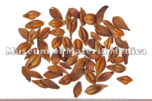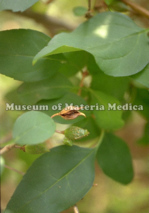Forsythia Fruit

|
Market name:連翹 Photo location:Museum of Materia Medica, Inst. of Nat. Med. TMPW No.:16017 |

|
Plant name:Forsythia suspensa Photo location:Toyama Pref., Japan Photo date:1995 Photographer:H. Fushimi |
| Synonym | Weeping Golden Bell |
| Latin name | Forsythiae Fructus |
| Botanical source: Family name | Oleaceae |
| Botanical source: Plant name | Forsythia suspensa Vahl (IPNI:608900-1) |
| Part used | Fruit |
| Empirical criteria for quality selection | Good one is fresh, large and light brown. The surface is smooth. (TN) |
| Constituents | Monoterpenoids: [F. suspensa]: Forsythide, Forsythide methylester Triterpenoids: [F. suspensa]: Oleanolic acid Lignans & Neolignans: [F. suspensa]: Arctiin, Arctigenin, Phillyrin, Matairesinoside, Matairesinol, Pinoresinol, Pinoresinol glucoside, Forsythiaside; [F. koreana]: Forsythin |
| Pharmacological effects | Diuresis, antibacterial (extract; Gram-positive, Gramnegative, tubercule bacillus). |
| Indications | As an antiinflammatory, diuretic, pus drainer and antidote, it is used to treat inflammation due to sores and skin disease. It is said to be good as a painkiller, for relieving vomiting and stimulating menstrual discharge. It is also an effective medicine in surgery. |
| Diseases | Rash, Pyogenic dermatosis, Enlarged lymph nodes, Fever, High fever, Disturbance of consciousness, Urodynia, Dysuria |
| Formulas | kagenryokakusan (asada) , kagenryokakusan (kyoteiken) , kyoseihatekigan , kufugedokusan , keigairengyoto , keibohaidokusan , saikoseikanto , jumihaidokuto , seijobofuto , senkanmeimokuto , jizusoippo , jizusoippokyodaio , dokkatsuto , bofutsushosan , maorenshoshakushozuto , ryokakusan |
| Meridian tropism | Heart, Gall bladder |
| Property | Slightly cold |
| Flavor | Bitter |
| Classification in "Shen-non Ben-cao Jing" | Inferior |
| TCM: Classification | Antipyretics |
| TCM: Medicinal effects | To remove toxic heat, to cause subsidence of swelling, and to eliminate nodulation. Used for carbuncles, boils, lymphadenitis, mastitis, erysipelas, upper respiratory infection, febrile disease at the early stage and at the stage with high fever, dire thirst, delirium and coma, and acute urinary infection with oliguria. |
| Remarks | Listed in the Japanese Pharmacopoeia 18th ed. |
| References | TN: T. Namba & Y. Tsuda ed., Outline of Pharmacognosy, a Textbook, 3rd ed., Nankodo Co., Ltd., Tokyo, 1998. |
DNA sequences of medicinal plants
| Gene Region | |||||||||||||||||||
| Nuclear | Chloroplast | Mitochondria | |||||||||||||||||
| Botanical source: Plant name | 5Ss | 18S | ITS1 | 5.8S | ITS2 | 26S | others | trnH-psbA | matK | trnK | trnK-rps16 | trnT-L | trnL | trnL-F | rbcL | rpoC1 | ndhF | others | |
|
|
|||||||||||||||||||
|
|
|||||||||||||||||||
